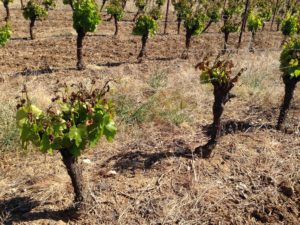Sometimes we forget that this part of France is not just thinly populated … it is rural. It is farmland. Vines, mostly, acres and acres of them, in every direction.
Towns are small and grew up here as places to support working in the vines. In our town, population 600, many of the garages we see are not for parking personal vehicles … they are for the storage of farm equipment needed to grow grapes as efficiently as possible.
Thus, the people here have almost a farmer’s view of weather developments. What they hope for is weather good for the growth of their crops, with special attention paid to the many things that can go wrong.
Such as freezing temperatures after the vines have begun to sprout.
Much of France was hit by frost in the past week, and the damage to vines has been extensive, even here in the Languedoc, which is hundreds of miles south of famous wine regions, like Champagne and Bourdeaux, and not as prone to freezes.
But you can see, in the photo, what sort of damage has been done to vineyards we can see from the balcony of our home.
To walk among them is to feel the growers’ pain.
The middle of this month was warm in much of France, and the vines got busy, sending out leaves, followed by tiny spheres that represent the forerunners of what are supposed to become bunches of grapes.
But then came a week when the temperatures reverted to something expected in February, not in late April. It is described as the worst siege of frost since 1991.
I became aware of the damage late frost can do when I lived in the Inland Empire, where citrus farming was a significant part of the economy even in the second half of the 20th century.
Once you smelled the sweet, almost thick scent of orange blooms … you had crossed into the danger zone — when the trees are throwing out new branches that will have trouble contending with harsh weather.
Everyone in the IE, pre-1980, knew what a smudge pot was — it was meant to burn oil that created a pall of smoke that hung over groves and often kept temperatures above freezing.
(It also created filthy air, and was eventually banned.)
The French vineyard owners have some tools in their box, but none are sure-fire answers to frost and many are expensive. Like, say, renting a helicopter that can hover over a vineyard at crucial times of day, such as dawn. The copter’s blades force warmer air downward. Or they can buy (or rent) heaters and wind turbines. Fires are sometimes lit as well, with pallets a common choice.
We toured the local vineyards the other day, and the damage varied significantly — plants lower in the valley seemed harder hit. Two rows might be blighted, but several more looked mostly OK.
Now, the growers wait. They know the yield in their vineyards will be smaller. The question is “how much”.
That will be an ongoing real-life story here for the next few months.


0 responses so far ↓
There are no comments yet...Kick things off by filling out the form below.
Leave a Comment